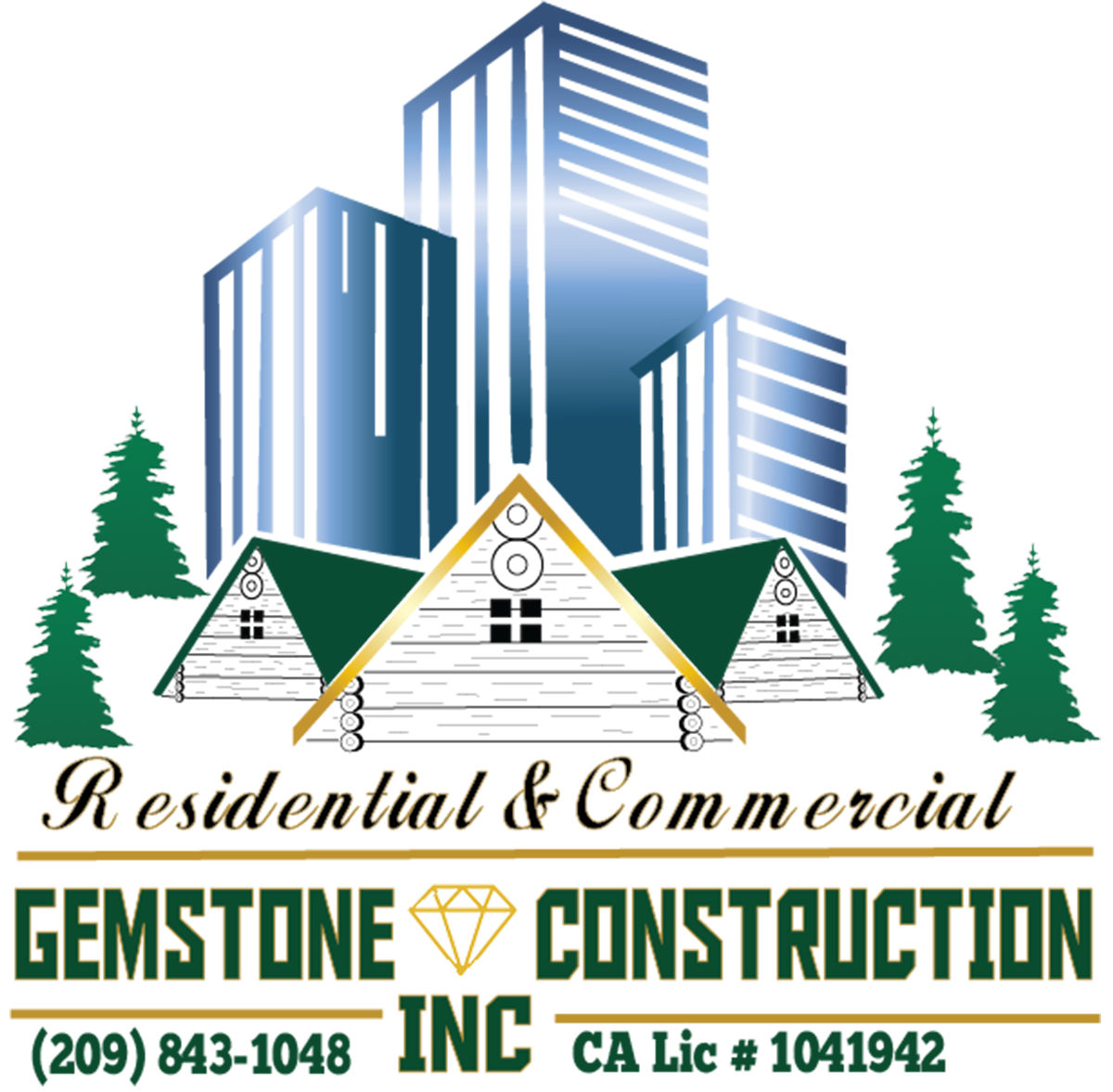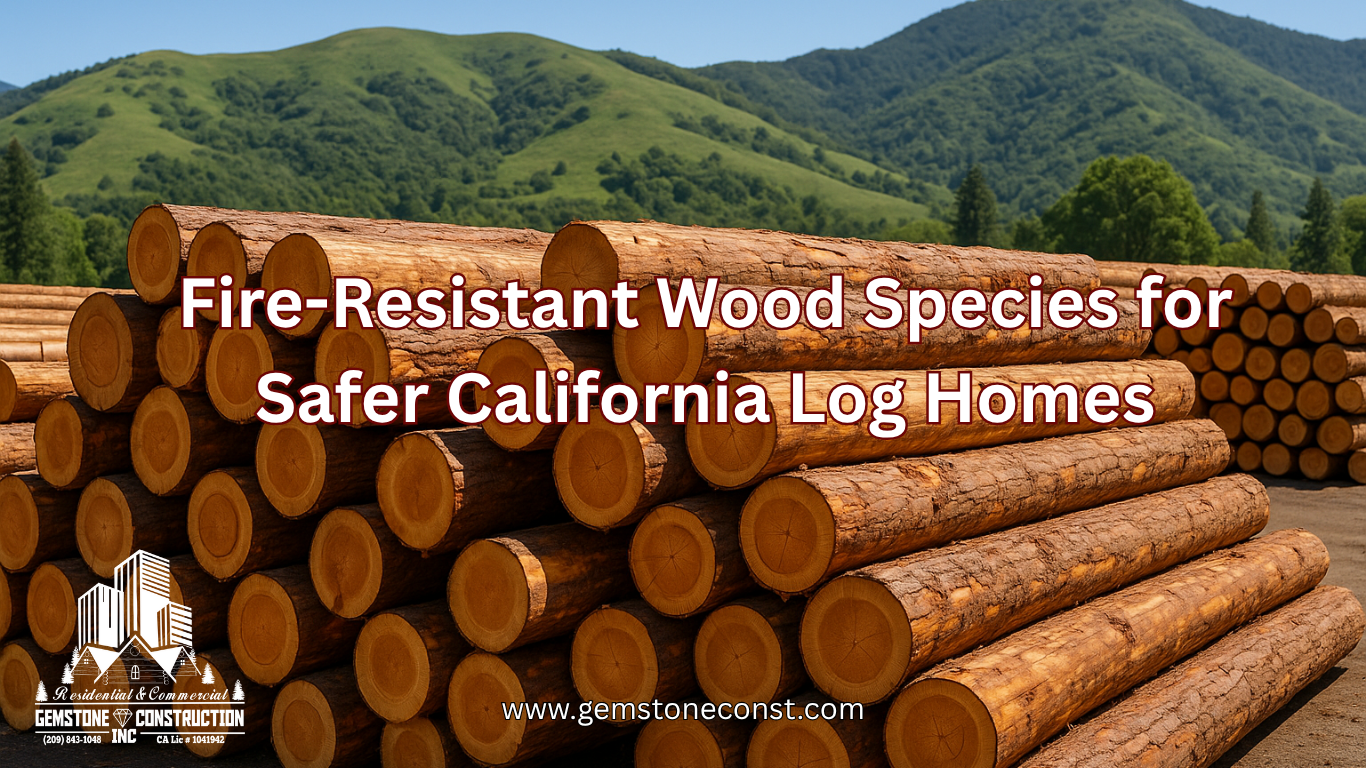GemStone Construction Blog
Fire-Resistant Wood Species for Safer California Log Homes
June 13, 2025 | Sacramento, CA USA
California’s wooded hills and pine-lined valleys inspire many dream-cabin sketches, yet those same trees now fuel longer, hotter wildfire seasons. State records show that more than twenty million acres have burned in just five years, and a growing share of that acreage sits inside wildland-urban interface zones where rural homes, barns, and ponderosa pines share the same ridgeline. When building, fire resistant log homes, choosing lumber that slows ignition is no longer an optional splurge; it is the ticket to permits, affordable insurance, and long-term peace of mind. This guide unpacks how lumber earns its flame-spread grade, which species naturally excel, and what design tweaks multiply their effect.
Dense, slow-charring logs buy firefighters extra minutes, keep evacuation routes safer, and often convince underwriters to issue policies that would otherwise be denied. Every paragraph ahead keeps the jargon light and the takeaways practical. By the end you will know what to ask your mill rep, how to read a test sheet, and where to find deeper design tips in our planning resource, plus a quick Q&A that clears up common code myths.
Why Wildfire Resistance Matters More Than Ever
California wildfire code now classifies roughly one in four homes as sitting in a wildland-urban interface, a technical way of saying “your siding is close enough to dry fuel that embers can bite.” That label automatically triggers Chapter 7A of the state building code, which rejects any exterior material scoring worse than Class B in flame-spread tunnel tests. Local plan reviewers enforce the rule with zeal, and lenders refuse construction draws when paperwork is missing. Insurance actuaries track the same data; filings reviewed by consumer groups show average rural premiums for non-compliant homes climbing more than 180 percent between 2020 and 2024.
Flame-spread numbers are not abstract theory. Field studies after the 2021 Dixie Fire showed that cabins clad in Class B lumber and boxed eaves had a survival rate more than double that of similar-sized structures built from untreated pine with open soffits. Those findings echo tunnel-test results published by the USDA Forest Service, which measured Western Red Cedar walls staying structurally sound about forty-five minutes longer than spruce when blasted by direct flame. Adding those forty-five minutes could mean the difference between a scorched exterior and a total loss.
How Lumber Earns Its Fire Rating
Building officials do not “eyeball” a log and guess safety; they rely on lab numbers. The benchmark test is ASTM E84. Technicians place a sample ceiling-side-down in a twenty-four-foot tunnel, drive 1 650 °F flames across one end, and record how fast the fire front moves. Results drop into three brackets: Class A (index 0–25), Class B (26–75), and Class C (76–200). California demands Class B or better for log walls in high-hazard zones.
A second trial, State Fire Marshal Standard 12-7A-1, exposes the same material to a wind-blown ember shower. To pass, the wood must stop glowing when the burners quit and show minimal penetration depth. Logs that clear both hurdles land on the state’s approved products list, and inspectors keep printed copies at their desks. One missing date or illegible stamp can stall a building permit for weeks.
Surface Ignition vs. Mass Ignition
Surface ignition strikes first. Fine sawdust, sap streaks, and tiny bark hairs catch within seconds of an ember landing. Those little flames radiate heat that dries the outer quarter inch, and soon volatile gases escape deeper fibers. If nothing interrupts the cycle, the entire log enters mass ignition—a runaway phase where temperature surges and structural capacity collapses.
Wood chemistry changes the sequence. Cedar, redwood, and cypress contain oils and minerals that smolder rather than flash. As a char shell forms, it starves the core of oxygen, delaying mass ignition and trimming flame-spread speed by up to fifty percent compared with white pine. That slower timeline buys responders precious minutes when every second matters.
Decoding Chapter 7A Paperwork
Chapter 7A ties approval directly to those tunnel numbers. Acceptable documentation lists species, grade, thickness, lab name, and a test date less than three years old. Many mills print the data on bundle sheets, yet smart buyers still cross-check against the Wildland-Urban Interface handbook hosted by California’s Department of Housing and Community Development. When you order specialty cuts, verify each profile carries the same rating; mixing uncertified sap-rich corners into a load can void the entire certificate.
Naturally Fire-Hardy Log Species
Not every project budget covers exotic hardwoods, and weight alone does not guarantee safety. In practice, three softwoods balance appearance, price, and performance for Northern California cabins.
Western Red Cedar
Western Red Cedar clocks a char rate near 0.83 mm per minute, nearly half that of lodgepole pine. Researchers at the Forest Products Laboratory recorded cedar walls standing intact about forty-five minutes longer than spruce under direct flame, even without chemical help. Its tight growth rings and phenolic oils smolder, forming a thick char crust that slows heat transfer.
Field advantages match lab scores. Cedar shrinks less than one percent across the grain, so checks stay hairline, denying embers an easy entry path. The main drawback is cost: full-heart cedar adds two to three dollars per board foot over white pine. Request WUI-rated, heart-center logs from your supplier, and insist on seeing the ASTM E84 sheet before sending deposits.
Redwood & Cypress
Heart-redwood’s silica and tannin cocktail pushes its flame-spread index into the low forties, securely inside Class B territory. Cypress lands in the same range thanks to resin pockets that frustrate termites and sparks alike. A USDA side-by-side showed heart-redwood advancing flames only 3.5 feet during a ten-minute tunnel run, whereas untreated white fir sprinted nearly seven feet.
Redwood often undercuts cedar north of Sacramento because mills sit closer to harvest stands, slashing freight miles. Cypress stains evenly and grabs long lag screws without cracking. Both species hide scorch marks better than pale pines, a cosmetic perk if stray embers ever brush the wall during a red-flag warning.
When Premium Logs Are Out of Reach
Lumber markets tighten each summer. If cedar or redwood stock runs thin, pressure-impregnated fire-retardant-treated wood (FRTW) can lift common spruce or pine to Class B. Treatment plants inject phosphate salts that foam into a glassy char once temperatures top 400 °F, choking oxygen at the surface. NFPA 703 spells out chemical retention levels and demands quarterly third-party audits, keeping mills honest.
Contractors often layer on intumescent coatings for belt-and-suspenders defense. These paints puff up to fifty times their dry thickness around 375 °F, blocking heat for several precious minutes. Expect a five-to-seven-year life before UV light erodes the outer microns; schedule a fresh coat every other stain cycle. Remember, coatings alone cannot raise Class C lumber to Class B on the plan sheet—you still need certified stock underneath.
Design Moves That Multiply Fire-Smart Logs
Choosing the right wood sets a strong baseline, but layout decisions decide whether embers ever test that rating. Begin with a full 100-foot defensible space zone. Swap bark mulch for crushed gravel, prune limbs ten feet above grade, and store firewood at least thirty feet away. Those basics deny flames an easy run toward the cabin.
Next, box eaves with ignition-resistant panels backed by one-eighth-inch steel mesh. Upgrade to seamless metal gutters that do not drip flaming plastic onto decks, and finish the roof with Class A metal standing-seam panels. Inside the wall assembly, use mineral-wool insulation that remains solid above 2 000 °F and blocks smoke from piping through log joints. For deeper siting tricks—like ridge orientation that sheds embers—check our planning resource on thoughtful cabin layouts (natural anchor).
Frequently Asked Questions
Does Western Red Cedar pass wildfire code without chemicals?
Western Red Cedar logs milled from dense heartwood consistently score within Class B during ASTM E84 testing, which satisfies Chapter 7A requirements for exterior walls in wildfire zones. The wood’s slow char rate lets walls hold shape even during a prolonged ember assault, and many building departments approve cedar packages once a recent lab sheet is on file. Underwriters often apply “preferred wood construction” credits that shave hundreds off annual premiums.
Plan reviewers will still reject loads if mill sheets are missing, illegible, or older than three years. Keep electronic copies with your permit set and on site during framing so inspections stay on schedule. If you order special profiles—hand-hewn corners, for example—verify the machine settings did not plane away too much heartwood, or you risk downgrading the rating.
How long does FRT treatment remain effective on pine logs?
Factory pressure treatments bond phosphate and sulfate salts permanently to the wood’s cellulose structure, and the performance lasts the life of the building as long as moisture stays below twenty percent. Manufacturers warrant exterior FRT logs for twenty-five years in wet coastal zones and “for life” in typical Sierra foothill settings, provided owners wash pollen off each spring, re-seal with a UV-blocking stain every three to five years, and maintain proper grade clearance.
When maintenance skips, weathering can erode the outer few millimeters where chemicals concentrate, slightly lowering flame-spread resistance. A simple field test—sand a quarter-sized spot, drip water, time absorption—flags when new sealer is due. In high-rain belts, add a borate wash every decade to refresh the surface salts and keep termites at bay.
Can boxed eaves be skipped if I install a Class A metal roof?
A Class A metal roof does block direct flame from above, yet wildfire loss studies show most cabin ignitions start from embers drifting sideways into vents or piling on ledges cluttered with pine needles. Post-incident surveys in the Dixie Fire revealed cabins with metal roofs but open soffits failed at nearly the same rate as asphalt-shingle homes. Structures that paired metal roofing with enclosed eaves, ember-resistant vents, and a cleared defensible zone survived more than sixty percent of the time.
Skipping soffit protection also leaves a Chapter 7A gap. The code either demands ember-resistant vents or enclosed eaves; meeting one rule while breaking the other frustrates inspectors and can void insurance credits. Combine the roof, boxed eaves, and mesh-screened openings to form a three-layer defense and keep permits, policies, and peace of mind intact.
Ready to Reserve Fire-Smart Logs?
Mill calendars tighten fast once summer arrives. Reach out to Gemstone Construction today, and our team will lock down your preferred cedar, redwood, or treated-log package before demand spikes. We handle test sheets, coordinate deliveries, and make sure every board meets California wildfire code so framing starts on schedule. Your dream cabin deserves a long, safe life—let’s secure your fire resistant log homes future together.
About Gemstone Construction
Gemstone Construction is a premier custom home and commercial building contractor serving Northern California, including the Sacramento area. Specializing in
custom log homes,
luxury home builds,
residential metal building construction, commercial construction and
commercial metal building construction. We bring craftsmanship, attention to detail, and personalized service to every project. From designing dream homes to building cutting-edge commercial spaces, our dedicated team ensures that each build reflects our clients' unique vision and exceeds expectations. Trust Gemstone Construction to transform your ideas into reality with integrity and excellence.
Learn more about Gemstone Construction

Contact Information



